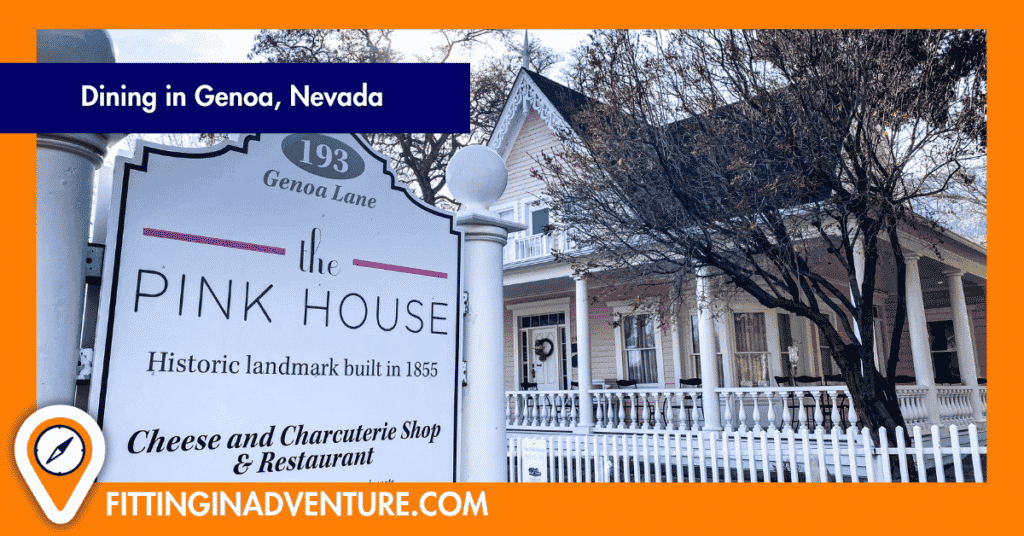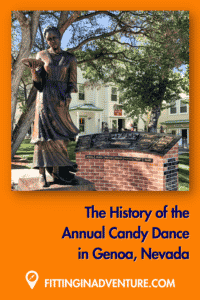The oldest permanent nonnative settlement in Nevada offers a unique step back in time. Unlike many historic towns, Genoa has maintained and embraced its history without turning into the theme park which has cursed other historic towns. The historic charm is highlighted by locally-owned restaurants and the quaint charm of yesteryear.
Disclosure: Some links on our site are affiliate links. If you purchase a linked item, we will make a commission, at no extra charge to you.
The first thing to know about your visit to Genoa. Yes, it is named for the Italian city, but it is pronounced Juh-NO-ah here in Nevada. The town was named by Orion Hyde, an elder in the Mormon Church who visited the trading post. Naming the town after the birthplace of Christopher Columbus, Genoa, Italy. Simply because during his 1855 visit, he felt like it had a similar vibe.
Lined with Victorian buildings at the foothills of the Sierra Nevada, Genoa’s Historic District is listed on the National Register of Historic Places.
Mormon Station State Historic Park: The Founding of Genoa
The area dates back to 1851 when Mormon traders established it as a permanent trading post on the Carson Route of the California Trail. Later named Mormon Station, the post allowed necessary provisions for travelers crossing the Sierra Nevada mountains.
The Comstock Lode and later California gold discoveries made Genoa an important center of activity until the route of commerce shifted with the building of the Central Pacific Railroad. The shift moved commerce from Genoa to nearby Minden.

Snowshoe Thomson: The Viking of the Sierra
From 1856 to 1876, John A. Thompson (commonly known as Snowshoe Thompson) trekked 90 miles over snowdrifts reaching 50 feet high and through blizzards to deliver mail to those living in the isolated location of the Sierra Nevada. All with a mail sack weighing more than 100 pounds of mail, medicine, and emergency supplies. This one man was the sole link between those areas and the Atlantic states during those winter months.
Coming to America at the age of 10 from Norway, the family settled in the Midwest before gold fever struck. In 1851, at the age of 24 Thompson drove a herd of cows to California and settled in Placerville. At this time, all attempts of postmen crossing the Sierra failed. Then in 1855, Thompson saw an ad in the Sacramento Union reading, “People Lost to the World; Uncle Sam Needs a Mail Carrier.”
While few had faith he would make the initial trek, Thompson fashioned shoes he’d seen as a child in Norway. The snowshoes later gave him his nickname as one person called out, “Good Luck Snowshow Thompson.” And a legend was born.
Two to three times each month for twenty winters, Snowshoe Thompson made the trek from Genoa to Placerville and back. Bears, mountain lions, and wolves roamed his path but paid him no attention. He often rescued prospectors caught in the snow, carrying them out on the back of his skis.
Snowshoe Thomson died of appendicitis which led to pneumonia on May 15, 1876. He was never paid by the U.S. Postal Service as he never had a contract. He is buried in the Genoa Cemetery marked by a headstone with crossed snowshoes and the words “Gone but not forgotten” and his name…misspelled.
Genoa Courthouse Museum
Renovated to serve as a museum in 1969, the building still houses much of its original oak furniture in the courtroom exhibit. The museum will walk you through the valley’s earliest inhabitants, the Washo to early settlers like Snowshoe Thompson.
Genoa Bar
Genoa Bar is Nevada’s Oldest Thirst Parlor. Established in 1853, the old sagebrush saloon hasn’t changed much since then. Some say the bar hasn’t been dusted since 1853 and that suits it just fine! Of course, there is indoor plumbing and electricity now. But the bar is the same. The mirror behind the bar? Ask the bartender to show you the diamond dust. This is one of two remaining diamond dust mirrors from the days of the Comstock Lode. The other is nearby in Virginia City.
Today it is a fun stop after a hike down Genoa Canyon Trail. (Yes, the Carson Valley area has a trail that ends at a bar!) Or a great place to enjoy some live music on a gorgeous afternoon. The throwbacks on this bar are in every nook and cranny.
Look up and you will notice a bra dangling near the ceiling. It once belonged to Raquel Welch. Bras used to adorn the entire area. On Ms. Welch’s visit, she was asked to add her bra. She responded, “only if it is the only bra.” So, the other bras were gathered and placed in the opened safe on the floor. (If you peak in the safe, you will be told to leave behind yours)
The worn bar is the same that once served the likes of Teddy Roosevelt, Mark Twain, Edward F Beale, Ulysses S Grant, Carole Lombard, Clark Gable, Red Skeleton, Johnny Cash, and Willie Nelson.
Be sure to try their famous Bloody Mary while there.

David Walley’s Hot Springs Resort (Holiday Inn Club Vacations)
It is with the great pleasure that I contribute an article in your valuable paper in regard to Walley’s Hot Springs…these springs, without a doubt, have no equal on this coast for the cure of rheumatism and all affliction that necessitate me visiting them. I now leave without crutch or cane, entirely well, not only relieved from pain but gained in spirit.
Mark Twain, 1887
While natural hot springs dot the Nevada desert, the most well-known (thanks Mark) is David Walley’s. Relax in one of the five on-site hot spring mineral pools while soaking in the history.
Shopping & Dining in Genoa
The historic district offers shopping and dining locally-owned options. With many choices, a couple of must-visits are The Pink House and Sierra Chef.

The Pink House
Another registered historic landmark, this 1855 Gothic Revival home has been painstakingly refurbished to its original splendor. The home was one of the first in Genoa but was originally painted white and located down the street. Oxen were used to pull the house, rolling on logs to its current location in 1870. The same year it was painted pink by the Johnson family.
The structure has been the site for much of Nevada’s history. Built by Col. John Reese, the home became a town hall of sorts, hosting meetings. Including the meetings which ultimately shaped the Nevada State Constitution.
Small dining rooms and a large outdoor patio (often shared with the local deer) are the perfect settings to enjoy. Behind the cheese counter, you will find a large selection of slice-to-order cheeses in a broad selection of types.
Sierra Chef
Nestled into the historic building across from the Mormon Station is Sierra Chef. Owned and operated by long-time local, Cynthia Ferris-Bennet. Cynthia offers meals and cooking classes in the space, as well as, pastries and other gourmet items.
You will notice the shop is covered in Ferris Wheels. There is a reason. Cynthia is the descendant of George Ferris, the inventor of the Ferris Wheel. He was said to be inspired in Carson Valley by a water wheel on the Carson River.
Nature in Carson Valley
It is impossible to visit the Carson Valley area and not take time to enjoy nature. The imposing mountains above you demand it while the abundant wildlife accents it. Take a stroll on some of the more than 60 miles of trails in the area. One of my favorite spots is this bench on North River Fork Ranch. The reflection of the mountains always joins you and sunset watching there is (usually) private and incredible!
The Carson Valley Chamber of Commerce hosts an annual event in January called Eagles & Agriculture. The event highlights the natural process of cattle birthing in the area. As the ranches have cattle, bald eagles descend on the area to feed on the afterbirth. Yes, it sounds disgusting, but as you see dozens of bald eagles in one place you will forget that part quickly.

Annual Candy Dance
Enjoyed by many since 1919, The Annual Genoa Candy Dance began as a fundraiser for the town. The town needed to purchase streetlights, but without a budget needed to rely on the idea of a group of women led by Lillian Virgin Finnegan. The women formed a group of volunteers to make candy to pass around during a dance. Genoa raised the funds for the streetlights and they lit the way for residents and visitors for about a hundred years (they recently needed replacing). The dance continued each year and still contributes to a large part of the town’s annual budget.
Regardless of the timing of your visit, one thing is for sure. You will fall in love with Genoa and Carson Valley.

